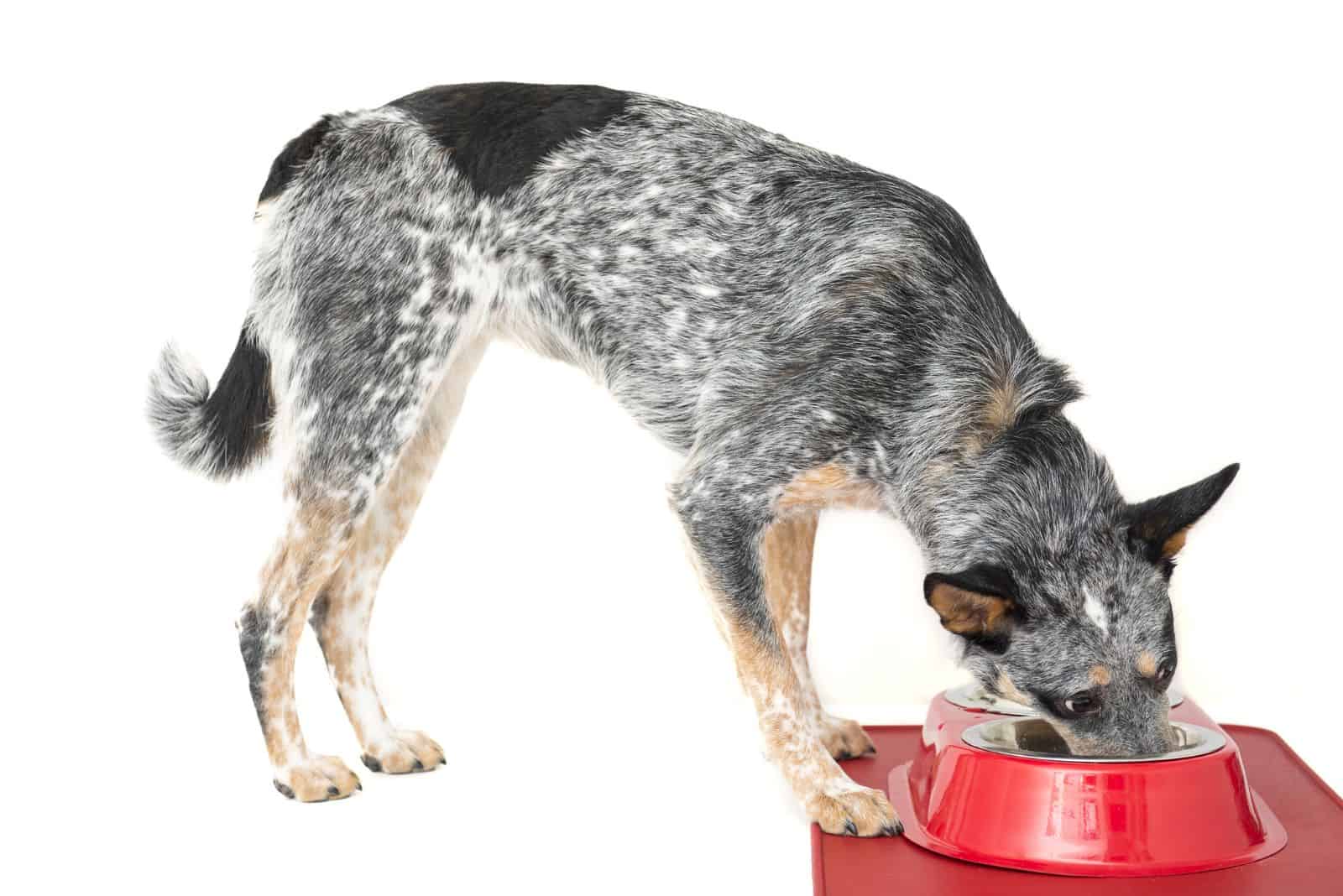Every fresh dog owner must be familiar with what’s the right diet for their dog. Kibble isn’t the only choice you can give to your dog. There are other ways to enrich a dog’s diet.
But first, how much should a dog eat on a daily basis? It’s great to know about a dog’s eating habits and nutritional needs, but we need numbers.
As a new Blue Heeler puppy owner, you definitely need insight into the Blue Heeler feeding chart and schedules. These charts should help you a lot with planning your dog’s meals and making sure you satisfy their daily needs.
A growing puppy needs more food than a senior dog. Adults are somewhere in between. What you should do is go through each life stage your dog is passing through and check out the recommended feeding guidelines.
Of course, there are some general rules. Some adult Blue Heelers won’t eat 4 cups of food every day. This is where you contact your vet and you two come up with a plan for feeding your dog properly.
The important thing is to listen to your dog and give him exactly enough of what he needs.
Blue Heeler Feeding Chart
What I’m about to show you is a general Blue Heeler feeding chart. You should keep it in mind if you’re a Blue Heeler owner, but you shouldn’t follow it blindly.
Feeding charts are of great help, but not every puppy will eat the same amount of food every day. Some pups are more gluttonous, while others will take the bare minimum.
I recommend you keep an eye on the chart and ask your vet for guidelines. It’s totally fine if your four month old Blue Heeler doesn’t eat the exact same amount of kibble that’s recommended. A half cup up or down is alright because not every pup’s stomach is the same.
The important thing is to have a happy and healthy dog, and that’s exactly what the Blue Heeler dog breed is. Maintaining a healthy weight and consuming the right amount of food for your Australian Cattle Dog puppy is what we’ll discuss now!
[table id=680 /]
How Much Should A Blue Heeler Dog Eat?
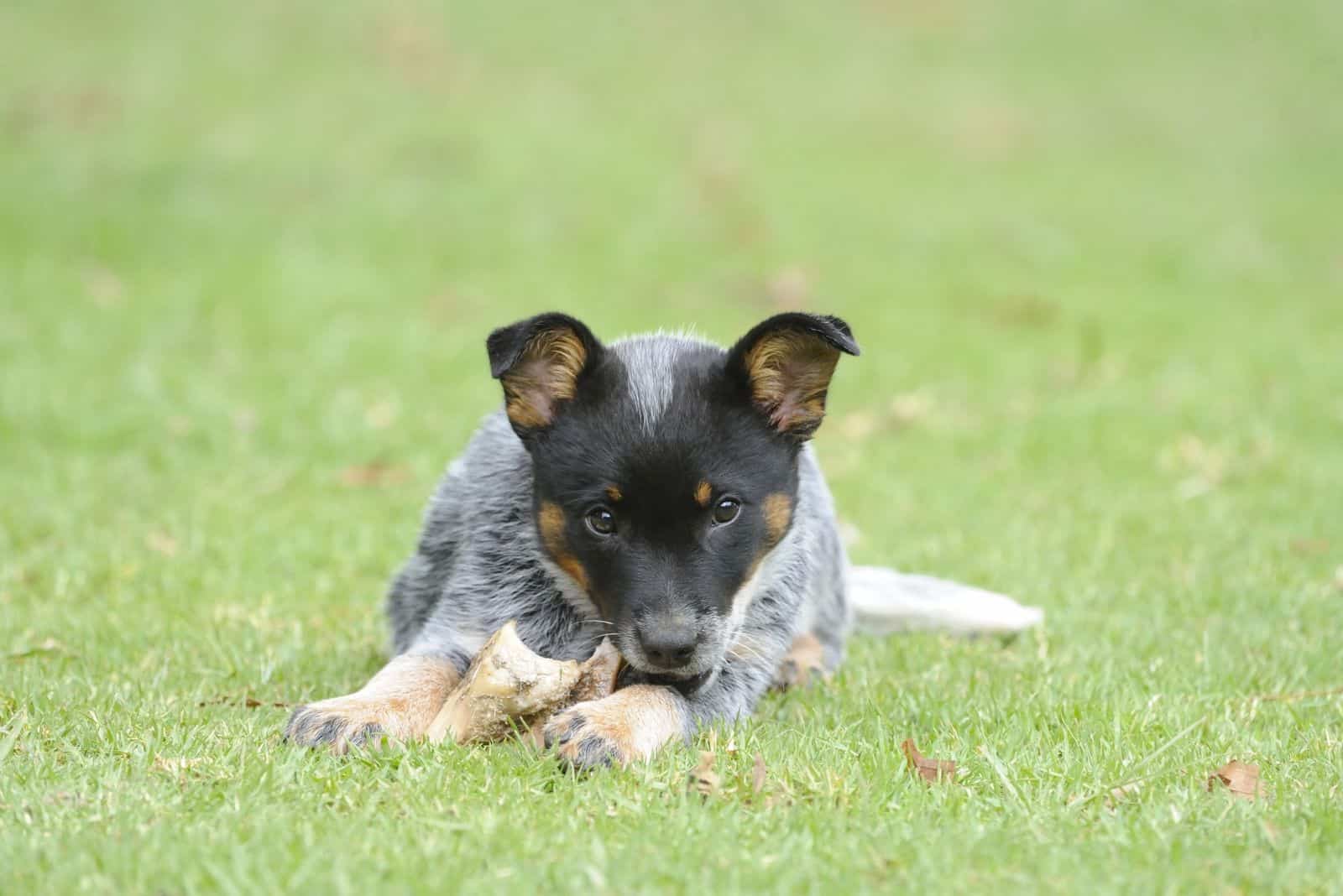
The matter of how much a Blue Heeler dog eats is linked closely to the quality of the food he’s eating.
The first thing you need to do when you’re getting a Blue Heeler puppy is to consult your vet about the food you should give him. Sure, dogs can eat pretty much anything, but that doesn’t mean it’s the right thing to do. Dogs need good quality food, just like humans.
If you’re not eating garbage, neither should your dog.
So, opt for great quality dog food. It doesn’t have to be too pricey to mean it’s of good quality. Some small brands offer excellent kibble, so do your research.
Now, for the matter of the amount.
A growing puppy and a senior dog don’t need the same amount of food. Adult dogs are a totally different story. So, we can’t have a general rule for feeding all Blue Heelers. Puppies, adults, and seniors all have different requirements.
I suggest we go through each life stage so you can be prepared for each age.
Puppyhood
We can divide puppyhood into two stages: early puppyhood and advanced puppyhood.
Newborn puppies are still dependent on their mom for food and comfort. They will consume only their mom’s milk for a few weeks. The human in charge of them will slowly introduce them to their first solid foods. It’s usually a liquid meal that becomes more solid as puppies grow.
Puppies will eat what is called a puppy mush. It’s softened puppy kibble mixed with warm water or formula. I don’t recommend feeding cow’s milk to your puppies, so don’t even make mush using it.
The amount of kibble your puppy eats in the first few weeks is rather small. You start with a 1/4 cup of food, but most of it won’t even be eaten. Puppies still enjoy their mother’s milk more than any kibble brand.
But the situation is about to change rather quickly.
As an unwritten rule, puppies increase their physical activity every two weeks, and thus their nutritional needs grow. They’re not small dogs anymore. They’re growing canines and need the right amount of nutrients.
The amount of food according to their weight chart will climb up to 2 to 3 cups of dry dog food a day. Follow Blue Heeler’s growth charts for more information.
Soon, your little pooch won’t be a pup anymore and you’ll have an adult dog.
Adult Stage
Puppyhood was a wonderful dog age, but now it’s time to grow up.
Blue Heeler dogs are pretty active and have high energy levels. Seems like they’re unstoppable and always keep on moving. A lot of physical activity will help your Blue Heeler maintain a healthy weight. No extra pounds mean your dog will live longer and steer away from health conditions like hip dysplasia or others that cause mobility problems.
According to the feeding guide from the beginning, you shouldn’t feed your adult Blue Heeler more than three cups of food a day. This should be enough for a dog with a high activity level.
Of course, make sure that you feed your dog a balanced diet, no matter the type of food he’s consuming. A healthy diet is more beneficial than you might think.
Senior Years
Senior years, or golden years as I like to call them, bring many changes to the dog’s life. Our canine buddies grow old, and old age can be great too. That’s why we need to ensure they’re fully healthy and happy as they approach the other end of their lifespan.
One of the best ways to ensure a senior dog is happy is by providing him with proper nutrition. Senior dogs don’t need the same nutrients as puppies and adult dogs. High protein intake isn’t in first place for them. Instead, they need a diet enriched with natural supplements like chondroitin and glucosamine.
The small dosage of food senior dogs have, should be boasting with goodies like amino acids, antioxidants, minerals for stronger bones, and vitamins.
This is also a stage where you should monitor for any unnecessary weight gain and try to improve your dog’s overall health status.
A senior Blue Heeler tends to eat around 2 cups of food daily. They’re no closer to the maximum amount of kibble recommended for these strong, working dogs.
Australian Cattle Dog Nutritional Needs
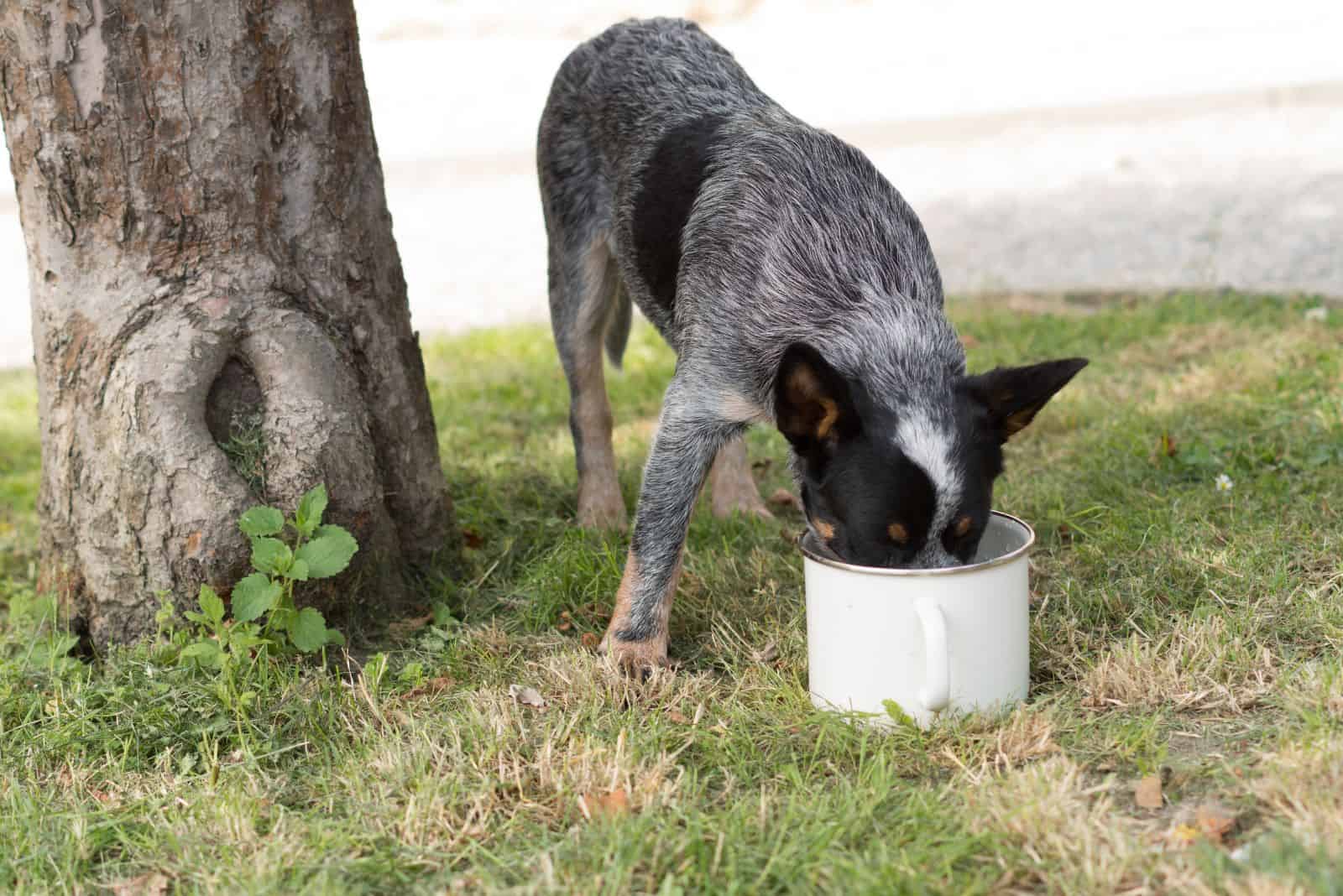
Every dog has nutritional needs he must fulfill. But those needs don’t really differ greatly from one dog to another. The thing is, some conditions will require more vitamins or minerals, but all in all, all dogs need the same ingredients and nutrition from their meals.
The most important part of any meal is proteins. Dogs of all stages, especially growing puppies need proteins to function properly, as well as to develop. Puppies are turning into adults, and they need fuel for their cells to duplicate and grow.
Adults also need proteins as fuel to move around without losing too much energy.
Lastly, seniors may not need as much protein as puppies or adult dogs, but they still must consume protein-rich food fortified with other supplements.
Every meal should consist of at least 70% of proteins. Make sure the meal or the kibble served is made using real animal proteins. It would be ideal if those proteins could come from lean muscle meat. In addition, organ meat and meaty bones should also be included.
If a meal consists of additional fruits, veggies, or grains, then it’s a feast. Dogs must consume fruits and veggies too! Are you aware of how many benefits they have for your pooch?
Of course, the biggest no is serving your pup too many carbohydrates. A well-educated dog lover like you should know that carbs only make dogs fat and provide small amounts of energy needed for good mental stimulation and physical activity.
Blue Heeler Meal Schedules
Humans eat five meals a day, three main ones, and two snacks.
But no matter how much we like our canine buddies, we can’t make them equal to us. Thus, dogs can’t have five meals a day.
Ideally, dogs should consume two meals a day. Well, adult dogs should, because puppies need more frequent meals. Don’t confuse mini Blue Heelers with puppy Blue Heelers. The first ones are adult dogs with the same food requirements as standard Heelers.
The general rule of thumb is to divide the daily recommended amount of kibble between the meals.
So, for example, if your dog is having two cups of kibble daily, he should consume one in the morning as his breakfast, and one in the afternoon as his dinner. Snacks should be optional and occasional, never going over 10% of a dog’s daily food intake.
Some dogs need to have their meals divided into a few more meals. Let’s say your Blue Heeler is having issues with bloat, so what you’ll do is listen to your vet and offer three to four small meals to your dog.
Naturally, the amount of kibble shouldn’t pass the recommended daily amount. You’re just dividing that kibble into one or two additional meals. Frequent meals in small quantities should help to reduce the chance of your dog getting bloat, as well as keep him fed.
Some dogs get a bit cranky if they have to wait for a meal for too long. However, you shouldn’t give in and hand out treats.
What’s The Best Dog Food For The Australian Cattle Dog?
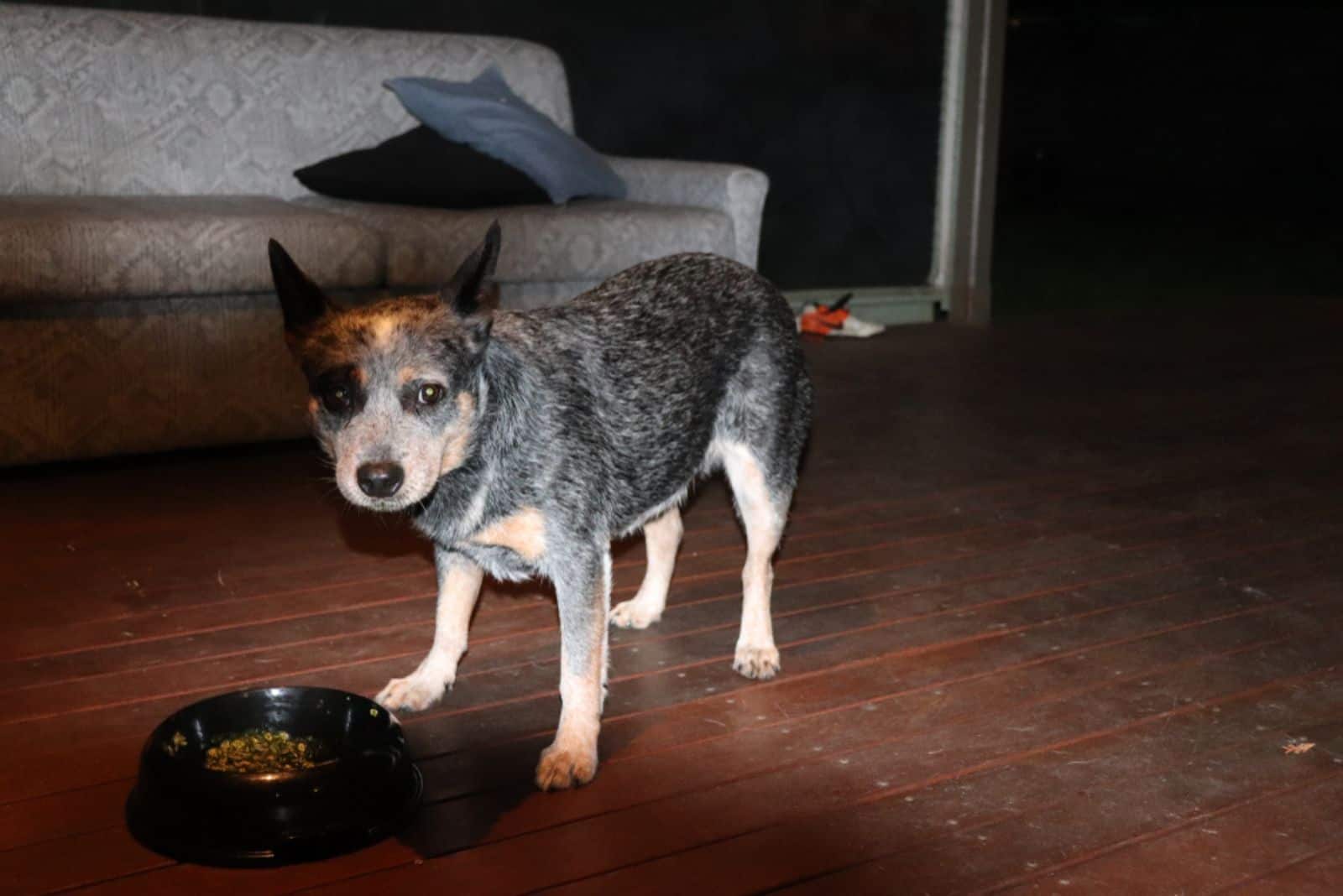
It’s not up to me to say which is the best food for your Australian Cattle Dog. It may be kibble, wet food cans, or raw food. I don’t know, because I don’t know your dog.
But do you know who does know your dog? You and your preferred veterinarian!
Finding the best food for your Blue Heeler can be a tough task. You could go through many bags of kibble and waste your money on so many brands before you find the food that suits your dog the best.
Dogs usually like kibble of any kind. But you should make sure you’re buying only the good stuff. This means food without any fillers, artificial flavors, preservatives, colors, etc. Let’s keep things natural.
Some dogs also like the combination of kibble and wet food. I wouldn’t advise serving only wet food because it can affect your dog’s dental health negatively.
Besides the first two options, dogs like Blue Heelers can also enjoy a raw diet. As you’ll see from the rest of this article, a raw diet is so beneficial for dogs of all life stages and breeds.
How To Switch From Puppy Food To Adult Food
When puppies first start eating, they start with puppy mush. As a good puppy owner, you should know how to prepare puppy mush. It will come in handy, also when your dog is feeling a bit down or has issues with its teeth and swallowing food. Learn how to prepare puppy mush here.
The total transition to solid food happens gradually. There’s no general rule for the kibble vs mash ratio. Watch your dog and listen to his needs. If your puppy seems ready to chew down the entire bowl of kibble, he’s ready for the full transition.
Puppy formulas are usually very different from adult formulas. They contain more proteins and supplements to support healthy growth. Once your puppy grows up, he won’t need additional supplements.
The transition to adult dog food happens somewhere around the puppy’s first birthday. But not every dog becomes an adult by the time he reaches 12 months of age. Some dogs become adults faster than others. Some even take up to 24 months to become adults.
But that doesn’t mean your puppy should consume puppy food up to the age of 2 years.
Your Blue Heeler breeder will tell you that your puppy should start the adult food sometime around its first birthday, but I say give it a try and see how your dog reacts. Any signs of loose stools or constipation might be a sign it’s too early, so start again later.
The transition should be gradual. This means you should switch a small amount of puppy kibble with adult kibble and increase the amount slowly until the whole bowl is now adult kibble for your Blue Heeler pup.
Should Blue Heelers Eat Raw Food?
I see no reason why dogs of all breeds shouldn’t eat raw. Rad dog food is so beneficial, and it doesn’t only consist of meat and meaty bones. There are so many ways you can enrich your dog’s raw diet, and I’m going to show you a few good starting points.
Eating raw is in all dogs’ DNA. Back when the first dogs were domesticated, dogs didn’t have special formulas or kibble to eat. So, what did they eat? Anything their humans managed to find or hunt. Their daily meals included meaty organs, bones, meat scraps, veggies, and basically any food leftovers.
As you can conclude for yourself, this kind of diet suited dogs. This lasted for centuries because the first kibble appeared some 100 or so years ago. But why did the humans turn to kibble in the first place? Well, it has a lot to do with lives becoming busy and ingredients becoming pricey. Not everyone has the time and the funds to support a raw diet these days.
Still, there are ways that could make a raw diet suitable for these hard times. If more people knew about nifty tricks linked to the raw diet, they’d definitely give it a try.
Raw diet needs are pretty much the same for any dog breed. So you can do some reading on the German Shepherd raw diet and Husky raw diet if you want to get a general idea for feeding your Heeler raw.
Daily Water Intake For A Blue Heeler Dog
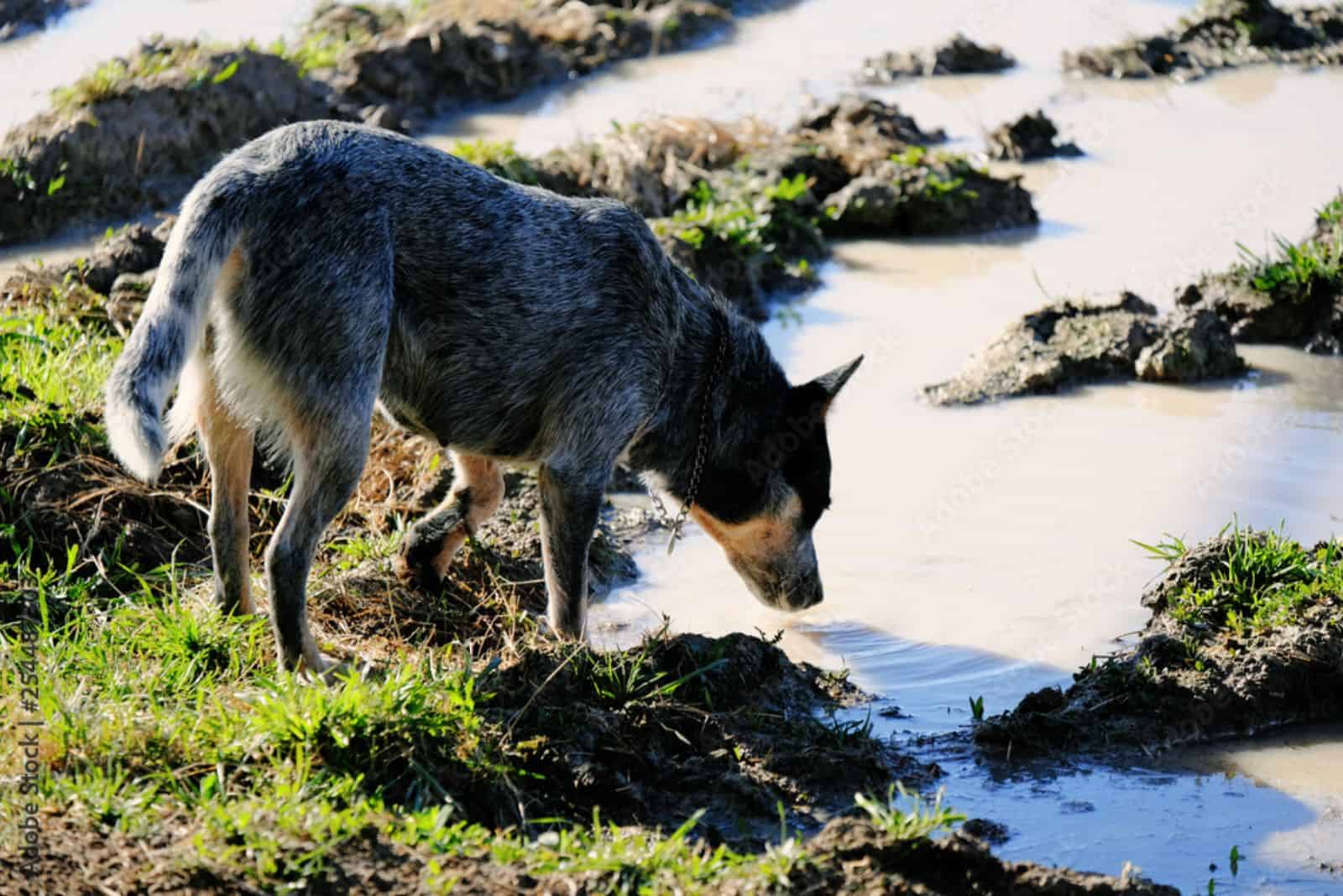
Free feeding is questionable, but free water intake is absolutely not.
Dogs should drink as much water as they want, anytime they want. You can’t restrict their water intake and plan it like you plan their meals. Water is necessary, another important fuel to keep them functioning properly.
As a rule of thumb, Blue Heelers should drink 1 ounce of water per pound of body weight. This is their recommended daily intake. Dogs usually chug down more water after their meals, or after a heavy exercise.
However, I’d be cautious to prevent bloat from striking your dog, so don’t really send your dog to the water bowl immediately upon finishing your exercises.
Dogs with bloat can still drink water, so watch for other symptoms too.
Water should be fresh, and bowls should be clean. There’s really no need to get your pooch bottled water. Tap will be just fine, as long as you’re drinking it too.
Keep the water bowl somewhere your dog can see it and where it’s easily accessible.
Lastly, watch out if your dog drinks enough water. If you notice the bowl is intact, monitor your dog because poor water intake may be a sign of some kidney conditions.
Should You Freefeed Your Blue Heeler
Absolutely not.
The answer is quite simple, but the explanation behind it can be a bit detailed.
It may sound like a good idea to have your dog free-fed. I understand everything: you’re working long hours, and you don’t have lots of time on your hands. How many times have you forgotten to eat breakfast? How many times have you skipped your own needs, just because you have something more important? Definitely a lot.
Well, a lot of people decide something will work out for them, even though it may bring so many bad things to their dogs. Free feeding is one of them.
Dogs should not be free-fed, especially if they’re prone to obesity. Some breeds are more prone to it, some are not. Laying out a bowl full of food so your dog can nibble on it anytime he feels hungry is never a good idea. For starters, you’ll be giving your dog more food than he needs.
Extra food on a daily basis will eventually lead your dog to put on more pounds than his bones and joints can take.
Blue Heeler Feeding Recommendation For Pregnant And Nursing Females
Pregnant and nursing Blue Heeler girls need special formulas because they’re in a whole different situation than male dogs. It’s definitely not easy to carry a belly full of babies for 60ish days and then take care of them for a few weeks. So, kudos to mommy Blue Heelers!
So, what do moms-to-be need to nibble on, kibble-wise?
Dog food brands have come up with formulas for expecting and nursing dogs. Those formulas are enriched with supplements and give extra energy so gals can carry out their pregnancies.
Pregnancy is a beautiful condition, but it drains so many vitamins and minerals from your Blue Heeler girl. Calcium is especially in deficit. So, look for recipes containing lots of calcium.
The nursing period also requires calcium and minerals for stronger bones, so puppies can grow up nicely.
I don’t recommend feeding your dog a raw diet while she’s pregnant. I realize that raw food brings many benefits, but it also contains potential issues like food poisoning and bacterial infections. Wait until your little gal is done with babies, and then you can feed her raw again.
Believe me, there are so many excellent, premium kibble formulas on the market, you wouldn’t know which to pick up!
No matter the brand you choose, your pregnant or nursing female should enjoy 2 to 4 times more calories than any other adult dog.
How To Measure Blue Heeler’s Weight
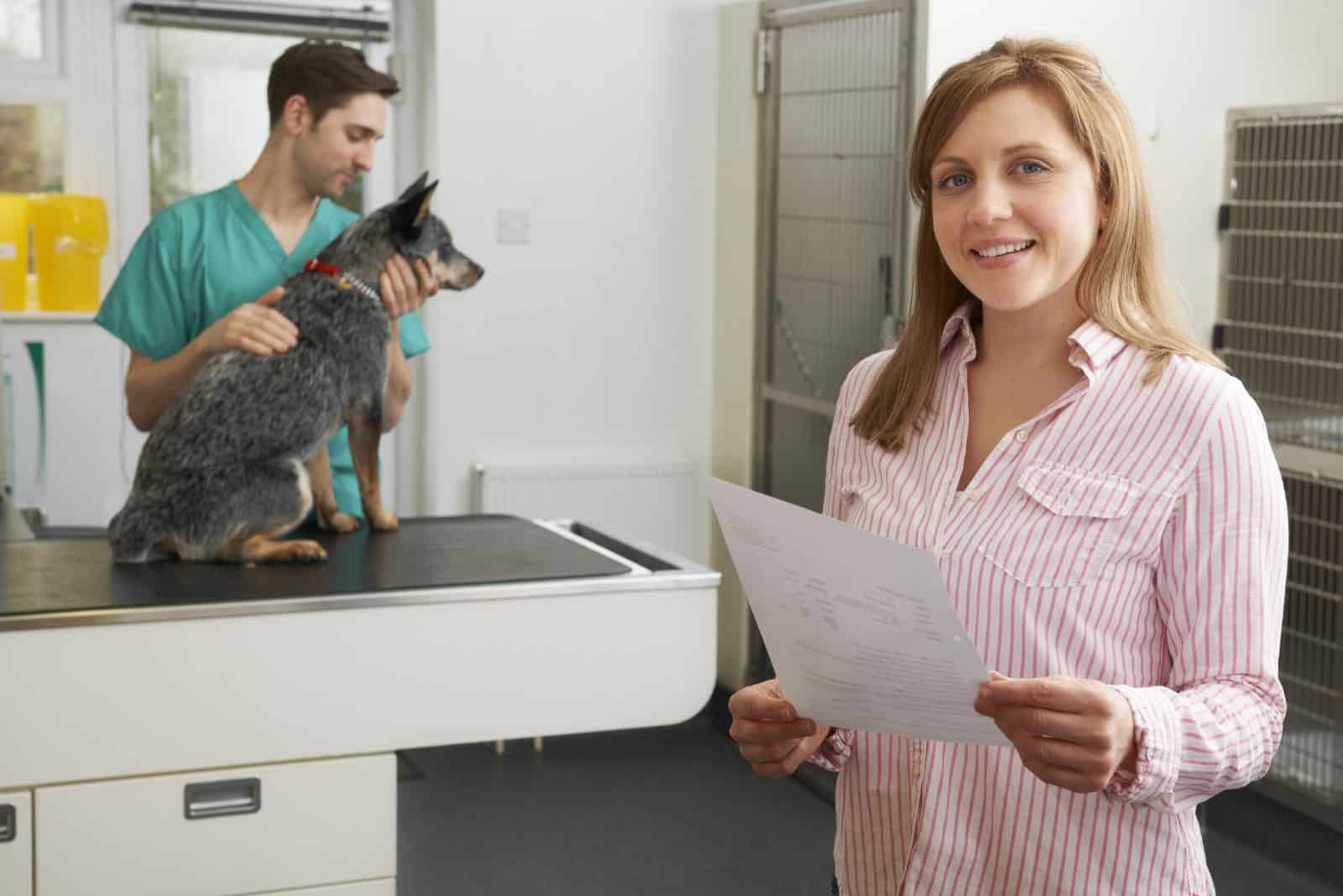
Do you wonder how heavy your dog should be?
Measuring a dog’s weight is easier than you think. You don’t need a fancy scale or to visit the vet to check out how much your dog weighs. Believe me when I say Knowing your dog’s weight is really important, especially if it’s a growing puppy.
Of course, no one says your dog should fit the breed’s growth chart blindly. There’s always some room to wiggle. It’s important that your dog is within a certain range. A few pounds up or down don’t really matter if your dog is active and healthy.
I want to clear something up. There are specialized dog scales, but you don’t really need one. Blue Heelers aren’t giant dogs, and you can absolutely measure them using a normal human scale.
If your dog is obedient, you can command him to sit on the scale and read what the scale says.
But that’s easy to do with adult dogs. Weighing puppies isn’t that easy because they’re curious and not that trained.
What you can do is weigh yourself, and then weigh yourself and your puppy. The difference between the two weights is your puppy’s weight.
As simple as that!
What To Do If Your Blue Heeler Is Overweight?
Dogs shouldn’t be overweight, no matter their breed.
Extreme weights can create so many issues for your dog. Pounds will put pressure on the dog’s joints and hips, and thus cause mobility issues. I shouldn’t even begin about potential cardiac issues!
The bottom line is keeping a healthy weight is crucial for your dog.
But, what to do if your dog becomes obese for some reason? Sometimes health problems can cause obesity. It’s not always a matter of overeating.
The first thing you should do is consult your vet. The vet should prescribe your dog a special kibble formula created to control the dog’s weight. There are lots of formulas for different conditions on the market, and they all do what they’re supposed to.
Of course, you should cut down on the amount of food. Your vet will tell you how much you should feed a Blue Heeler puppy if he’s struggling with obesity.
Usually, it’s a matter of half a cup to one cup for extreme cases, but it really makes a difference.
Exercise Needs For A Blue Heeler Dog
An obese dog needs to exercise a lot. But Blue Heelers aren’t that obese or prone to obesity.
However, it can happen to every dog, and it’s not a big deal, because obesity can be treated.
Healthy exercises are the best treatment for obesity.
Blue Heelers are generally active dogs. Just look at their origin! These pups were used to herd cattle. This role demanded (still does) lots of stamina and agility. Shepherd or herding dogs need to be fast, think fast, and react in time.
You don’t have to own a ranch to be a Blue Heeler owner. But you do need to provide almost the same amount of exercise as they would have on a ranch
I know it’s hard to commit to two hours a day, but there are ways to fulfill their needs. If you’re busy with work, you can hire someone to walk your dog or enroll him in a doggy daycare where he can play as much as he wants with his buddies.
I do suggest you play with your dog, for at least a while. Blue Heelers get deeply bonded during playtime, and you both can benefit from it.
To Sum Up…
Every Blue Heeler feeding chart you saw today will be of great help once you get your Blue Heeler puppy home. As a new dog owner, you must know two things regarding dog food: your dog needs high-quality recipes, and your dog needs the appropriate amount of kibble.
No overfeeding, no feeding your dog nonsense. No such things. Get your Blue Heeler pup on a healthy diet today, so you can expect many happy years together in the future.
